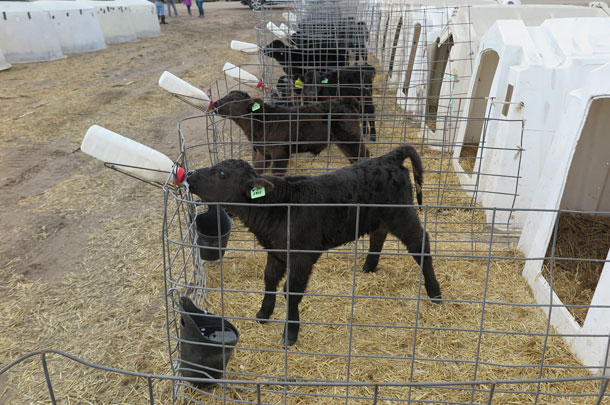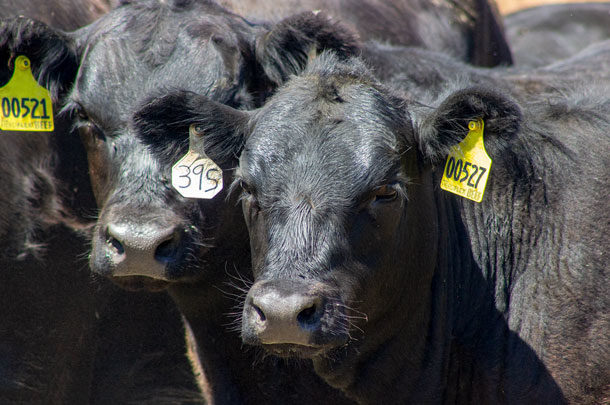Dairy herds are looking for every advantage they can find these days. Diversifying into the beef market is one such avenue that offers multiple options to choose from:
- Dairy-beef crossbreeds
- Straight-dairy calves raised for beef
- Full-beef calves
When it comes to using beef genetics within a dairy herd, not all options offer the same value. Incorporating full-beef embryos as a strategy in your breeding program delivers full-beef calves, providing herds with flexible management and diversification options and, ultimately, the opportunity for a stronger return on investment from these premium and sought-after animals.
Here are three ways a full-beef embryo breeding program can benefit your herd:
1. Manage heifer inventories while advancing herd genetics
Until recently, many dairy operations would retain all the heifers they produce to use for replacements, expand the dairy or sell as springers for extra income. The advent and increased use of sexed semen and other technologies, such as genomic testing, have changed this practice and allow producers to be more strategic in their breeding programs. This has created a situation where only a fraction of the herd is needed to meet replacement requirements.
Cows and heifers with lower genetic merit make excellent in vitro fertilization (IVF) recipients, allowing farms to still gain lactation benefits while elevating the genetic makeup of the herd. Beef embryos offer commercial dairy herds an opportunity to continue advancing elite genetics within their herd while managing heifer inventories and allowing for further diversification. The use of full-beef embryos to create a full-beef calf is gaining traction among herds who want to further diversify their revenue streams.
2. Flexible marketing options to meet your herd needs
Using beef embryos allows the dairy operation to explore different opportunities to increase their revenue per calf. Some of these options are as follows:
Day-old
Traditionally, many calves destined for the beef supply chain from a dairy entered the stream at a day-old. The values received for these cattle at this point continue to decline due to various market factors. Using full-beef embryos offers an opportunity for dairies to recover some of the premiums that have been lost and increase the revenue received from the sale of calves.
Weaning
A second timepoint where a greater value for the calf can be realized is at weaning. The dairy can take advantage of a full-beef calf’s increased efficiencies to gain weight. Traditionally, within the beef industry, calves are marketed at weaning. Many feedlots and backgrounders prefer to receive cattle at weaning. This provides an opportunity for additional bidding competition for calves, increasing the likelihood of receiving a higher price than selling at a day-old.
For instance, New Heights Dairy in Minnesota uses beef embryos and weans full-beef calves at 60 days with calves weighing an average of 225 pounds. Calves are then sold to a local cattle feeder for approximately $2 per pound. As larger loads of full-beef calves are put together, the feedlot has offered to pay a higher premium for calves.

New Heights Dairy in Minnesota has experienced higher demand for their calves after switching to full-beef breeding using beef embryos. Photos courtesy of Simplot Animal Sciences.
Fed cattle
A third possible scenario is for the dairy to raise the animal beyond weaning, all the way to finish. The fed cattle can then be marketed to a packer by contract, direct to consumer or a combination of the two.
Recently, the general public has shown a renewed interest in purchasing food directly from producers. This has resulted in many local butcher shops being booked for the next 6-9 months in some areas.
Some dairies utilize full-beef embryos in their operations to direct market fed cattle right to the consumer. They have the flexibility to market finished beef in whole-, half- and quarter-beef formats or as individual cuts in a meat case at various local grocers.
Other dairies raise the full-beef calf all the way to harvest and market the calf on the beef grid via contract or the open beef market. Full-beef cattle can also be sent to a custom feedlot specializing in feeding beef cattle, allowing the dairy to retain ownership and market the fed cattle to the packer when ready to harvest. Selling fed cattle allows dairy producers to realize the efficiencies associated with the full-beef calf but requires more risk management on their part than other options.
3. Added value compared to other breeding programs
Full-beef calves are sought after by the beef supply chain and can earn a premium price compared to their dairy-beef cross and straight-dairy calf counterparts. Full-beef calves finish in fewer days with a more suitable mature size, deliver a cost-per-pound gained advantage and offer improvements to operations feeding out cattle to harvest.
A recent economic analysis by Dr. Larry Corah, an emeritus professor specializing in beef production at Kansas State University and a supply chain consultant for Select Sires, showed that full-beef calves have a $100-per-calf potential profit advantage versus Holstein-beef crosses. The evaluation was based on full-beef calves’ improved feed efficiency, increased rate of gain, higher carcass weight and the ability to grade higher at harvest.
Corah believes comparing full-beef calves to Jersey beef cross’s profit differential has the potential to be even greater.
The use of beef embryos provides a dairy operation with diverse options for the marketing of their calves to increase profits. Each operation is different and must weigh all alternatives prior to moving forward with a scenario. Talk with your local genetic consultant about possibilities for beef diversification and embryo opportunities for your herd.







